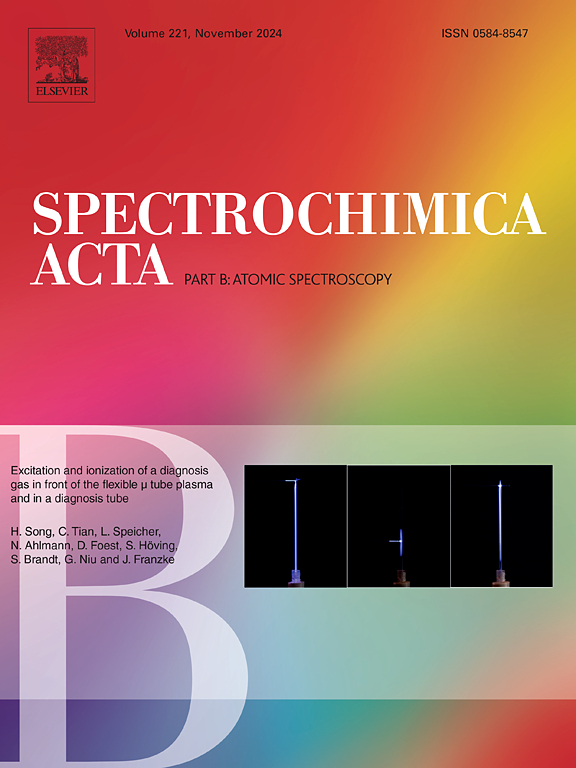A 3-D simulation model for X-ray path length and yield variation in micro-PIXE analysis of rough surfaces
IF 3.8
2区 化学
Q1 SPECTROSCOPY
引用次数: 0
Abstract
A crucial aspect of PIXE/XRF analysis is accurately modeling the behavior of emitted X-rays as they traverse the sample, significantly influencing the intensity and detectability of the X-rays. This study presents a comprehensive simulation program designed to model surface topography and calculate X-ray path lengths in 1-D, 2-D, and 3-D views of samples. The model is applied to Micro-PIXE analysis and integrates key physical parameters, including stopping power, X-ray production cross-section, photon attenuation, and local photon creation to estimate the correct X-ray intensity map. Additionally, the simulation accounts for severe surface roughness, where X-rays may exit and re-enter the sample multiple times along their trajectory toward the spectrometer. The X-ray path length and its effect on the accumulated X-ray yield are calculated on both mathematical surface topography and experimental data obtained from Micro-PIXE using a four-segment silicon drift detector (SDD), revealing a remarkable correlation that underscores the importance of detailed X-ray path length calculations. By demonstrating the impact of path length on the accumulated X-ray yield for rough surfaces of varying microscale, this approach could enhance the accuracy of X-ray intensity predictions, leading to more precise elemental composition analysis in X-ray spectroscopy techniques.

粗糙表面微pixe分析中x射线路径长度和良率变化的三维模拟模型
PIXE/XRF分析的一个关键方面是准确地模拟发射的x射线穿过样品时的行为,这显着影响x射线的强度和可探测性。本研究提出了一个全面的模拟程序,旨在模拟表面形貌并计算样品的1-D, 2-D和3-D视图中的x射线路径长度。该模型应用于Micro-PIXE分析,并集成了关键物理参数,包括停止功率、x射线产生截面、光子衰减和局部光子产生,以估计正确的x射线强度图。此外,模拟还解释了严重的表面粗糙度,在那里,x射线可能沿着它们走向光谱仪的轨迹多次离开和重新进入样品。利用四段硅漂移探测器(SDD)从Micro-PIXE获得的数学表面形貌和实验数据,计算了x射线路径长度及其对累积x射线产率的影响,揭示了显著的相关性,强调了详细的x射线路径长度计算的重要性。通过展示路径长度对不同微尺度粗糙表面累积x射线产率的影响,该方法可以提高x射线强度预测的准确性,从而在x射线光谱学技术中实现更精确的元素组成分析。
本文章由计算机程序翻译,如有差异,请以英文原文为准。
求助全文
约1分钟内获得全文
求助全文
来源期刊
CiteScore
6.10
自引率
12.10%
发文量
173
审稿时长
81 days
期刊介绍:
Spectrochimica Acta Part B: Atomic Spectroscopy, is intended for the rapid publication of both original work and reviews in the following fields:
Atomic Emission (AES), Atomic Absorption (AAS) and Atomic Fluorescence (AFS) spectroscopy;
Mass Spectrometry (MS) for inorganic analysis covering Spark Source (SS-MS), Inductively Coupled Plasma (ICP-MS), Glow Discharge (GD-MS), and Secondary Ion Mass Spectrometry (SIMS).
Laser induced atomic spectroscopy for inorganic analysis, including non-linear optical laser spectroscopy, covering Laser Enhanced Ionization (LEI), Laser Induced Fluorescence (LIF), Resonance Ionization Spectroscopy (RIS) and Resonance Ionization Mass Spectrometry (RIMS); Laser Induced Breakdown Spectroscopy (LIBS); Cavity Ringdown Spectroscopy (CRDS), Laser Ablation Inductively Coupled Plasma Atomic Emission Spectroscopy (LA-ICP-AES) and Laser Ablation Inductively Coupled Plasma Mass Spectrometry (LA-ICP-MS).
X-ray spectrometry, X-ray Optics and Microanalysis, including X-ray fluorescence spectrometry (XRF) and related techniques, in particular Total-reflection X-ray Fluorescence Spectrometry (TXRF), and Synchrotron Radiation-excited Total reflection XRF (SR-TXRF).
Manuscripts dealing with (i) fundamentals, (ii) methodology development, (iii)instrumentation, and (iv) applications, can be submitted for publication.

 求助内容:
求助内容: 应助结果提醒方式:
应助结果提醒方式:


